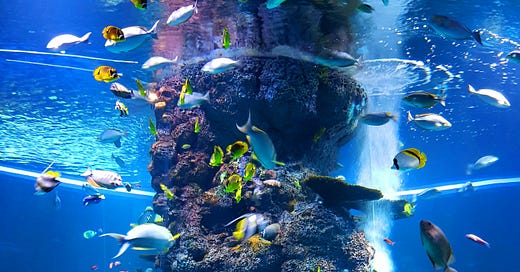Ecosystem Beast Mode🪸🐠🤑: Reefs>Unicorns:
Dear Impact Star,
A few weeks ago, I found myself snorkeling off the coast of Mexico.
”Don’t go in unless you’re a great swimmer, the current is strong,” the guide warned us.
Overconfident, I dove in. I wanted to see the coral reef.
The seas were rough. I didn’t know how I was going to get back to the boat.
Then I looked down—and there it was. The reef: Bleached coral. Barely any fish.
This was once a thriving, interconnected ecosystem. Not anymore.
Then, a few days ago, a founder from Silicon Valley shared how his company IPO’d for tens of billions of dollars — He said it wouldn’t have happened without his investors, YC startup founder network, and all the people in the valley who helped him along the way. There were many times when they almost threw in the towel. But over 5 years, they managed to turn a million dollars into billions because somehow at the right time, the right person stepped in to help them.
But what about the world’s biggest challenges—oceans, biodiversity loss, regeneration?
Grants and investments land like seeds in the wind.
Billions lie idle in DAFs and foundations, unspent.
Words like climate change get politicized… and truly transformative solutions struggle to scale.
I kept asking myself why.
Then it clicked while walking my dog Josie yesterday in the snow.
Nature (and Silicon Valley) both leverage Ecosystem Beast Mode.
Reefs thrive because they’re systems. Coral, fish, algae, and predators don’t just coexist—they collaborate. The entire system becomes stronger through competition, collaboration, and compounding impact.
The Silicon Valley model works so well is because:
Startups that compete with each other, but also collaborate and help each other.
Investors that share deal flow while sometimes vying for the same deal.
A network of trusted partners take a company from an idea to IPO.
It doesn’t just happen in isolation as the media likes to tell the story.
It takes a thriving reef.
What if we turned on Ecosystem Beast Mode?
What if we showed up not just individual products or projects, but entire systems of innovation that are stronger together?
I posit that we naturally take Ecosystem Beast Mode even further because we are driven by a unifying mission that’s more motivating than money: leaving the planet better because we did our part.
Plus, many of our solutions are about leveraging nature’s own network effects.
Unleash Ecosystem Beast Mode
Funders: Instead of a portfolio of isolated bets, what if every investment strengthened the others, creating resilience and exponential returns? This is just the tip of the iceberg — I’ve designed an entire framework that takes this as far as you want to go. So the question is — how far do you want to go?
Innovators: What if your pitch wasn’t just about your product but about the ecosystem your solution amplifies? Funders want to see that you’re resilient, connected, and have all the odds stacked in your favor. Why not give it to them?
Here’s where it gets wild:
When we operate in Ecosystem Beast Mode, we unlock exponential value.
1 + 1 + 1 doesn’t equal 3—it equals 10.
VCs love talking about the Power Law, but this Human Network Effects Law is what powers up the Power Law — and yet, we aren’t fully leveraging it to our advantage.
The Role of Super Nodes
Super nodes in the system create ripple effects that transform everything around them. For example, imagine this florescent green coral. It lights up the entire reef.
Not everyone needs to be a super node, but if you decide you want to play that role, then we design a very specific roadmap. It’s not for everyone. But when you’re ready, you’re ready. You know it.
Systems thinking isn’t new. Nature’s been doing it for billions of years. In a forest, trees compete for sunshine, but under ground, their roots share nutrients and information through fungi networks. Mangroves shelter more than 60% of all tropical fish species during their first few weeks of life. This is a mangrove we saw on the way to the reef, still alive but barely.
When we design funding systems inspired by reefs, forests, or mangroves, we stop throwing food pellets for a single fish species and start building ecosystems where all of them can regenerate.
When members of an ecosystem start working together, this makes life easier for all involved including the funders.
Your Quick Win
Innovator?
Stop pitching yourself as a lone fish.
Position yourself as part of an ecosystem.
Map out how your work amplifies others and how others amplify you.
Funder? Ask yourself:
Are you funding individual fish? Or are you also building reefs?
The difference determines whether your capital has exponential impact—or gets lost at sea.
How do you know if you’re ready for Ecosystem Beast Mode? It is not for everyone.
You’ve built a portfolio of grants or investments (or both), and now you want to unleash network effects. If you’re just starting a fund or foundation, you can set it up right from the get-go with an Ecosystem Mindset but we won’t be able to see results till you start deploying capital so keep that in mind.
You’re building a super node solution, but without connecting it to the rest of the network, you know you’re coming across as a fish.
Starting in February, I’m open to working with funders and innovators who are ready to unleash Ecosystem Beast Mode as an EIR / partner focused entirely on developing this strategy with you.
Let’s turn $1 Million into tens of billions in prosperity—but more importantly, let’s scale solutions that humanity desperately needs at warp speed by working together instead of alone.
It’s more fun to build exponential network effects into the mix. And if we’re not having fun, why bother?
Warmly,
Neesha
Thanks to Evan Lam for sharing this feedback:
"You clearly have a deep understanding of the type of work you do, as well as your approach, and that clarity . It's energizing, contagious and one of the reasons I looked forward to getting your email..."
How did you enjoy this email? Reply and let me know!







